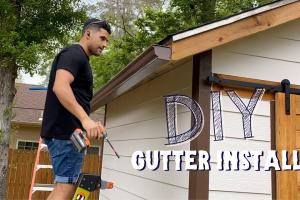Complete Guide to Installing Rain Gutters on Your Shed: A Step-by-Step Approach

-
Quick Links:
- Introduction
- Why Rain Gutters Are Important
- Types of Rain Gutters
- Tools and Materials Needed
- Measuring and Planning Your Gutter Installation
- Installation Process
- Maintenance Tips for Shed Gutters
- Case Studies: Successful Gutter Installations
- Expert Insights
- FAQs
Introduction
Installing rain gutters on a shed may seem like a daunting task, but it’s essential for protecting your investment. Rain gutters help direct water away from your shed, preventing water damage and promoting longevity. This guide will walk you through the process step by step, ensuring you have all the information you need to complete this valuable home improvement project.
Why Rain Gutters Are Important
Rain gutters serve several crucial functions, including:
- Water Management: Properly installed gutters can prevent water pooling around the foundation of your shed, reducing the risk of rot and decay.
- Soil Erosion Prevention: By directing water away from your shed, gutters help minimize soil erosion, preserving your landscape.
- Improved Aesthetics: Gutters can enhance the appearance of your shed, giving it a more polished look.
Types of Rain Gutters
There are several types of rain gutters to consider for your shed:
- K-Style Gutters: These are the most common type of gutters and are typically more aesthetically pleasing.
- Half-Round Gutters: These offer a classic look and work well for sheds with a more rustic design.
- Fascia Gutters: These are built into the fascia board and are ideal for modern sheds.
Tools and Materials Needed
Before you begin, gather the following tools and materials:
- Level
- Measuring tape
- Gutter sections
- End caps
- Downspouts
- Gutter hangers
- Sealant
- Drill
- Safety goggles
- Ladder
Measuring and Planning Your Gutter Installation
Accurate measurements are critical for a successful gutter installation. Follow these steps:
- Measure the length of the shed where the gutters will be installed.
- Determine the slope needed for the gutters (typically a 1-inch drop for every 10 feet).
- Plan the locations for downspouts, ensuring they direct water away from the shed.
Installation Process
Now that you have your measurements, it’s time to install the gutters:
- Attach the Gutter Hangers: Space the hangers every 24 inches along the length of the shed.
- Install the Gutter Sections: Connect the gutter sections, ensuring the correct slope towards the downspouts.
- Seal the Joints: Use sealant to secure joints and prevent leaks.
- Attach Downspouts: Secure downspouts to the gutter and direct them away from the shed.
Maintenance Tips for Shed Gutters
To ensure your gutters function effectively, regular maintenance is crucial:
- Clean gutters at least twice a year to remove debris.
- Inspect for leaks and repair them promptly.
- Check the alignment to ensure water flows correctly.
Case Studies: Successful Gutter Installations
Consider the following examples of successful gutter installations:
- Case Study 1: A homeowner used K-style gutters on their shed, resulting in a 30% reduction in water pooling.
- Case Study 2: By adding half-round gutters, another homeowner not only enhanced aesthetics but also improved drainage efficiency by 40%.
Expert Insights
According to home improvement specialists, investing in quality materials and proper installation techniques is key to maximizing the lifespan of your shed gutters. Regular maintenance is equally important, as ignoring it can lead to costly repairs.
FAQs
- What is the best material for shed gutters? Aluminum and vinyl are popular choices due to their durability and ease of installation.
- How often should I clean my shed gutters? It’s best to clean them at least twice a year, or more frequently if you have overhanging trees.
- Can I install gutters on a shed myself? Yes, with the right tools and materials, DIY installation is feasible for most homeowners.
- What is the ideal slope for gutters? A slope of 1 inch for every 10 feet is recommended to ensure proper drainage.
- Do I need a permit to install gutters? Check local building codes; permits may be required depending on your location.
- How do I prevent clogs in my gutters? Consider installing gutter guards to keep debris out and reduce maintenance.
- What are the signs of a gutter leak? Look for water stains on the shed wall or pooling water around the foundation.
- Can I use PVC for gutters? Yes, PVC is a lightweight and affordable option for gutters.
- How long do gutters typically last? With proper maintenance, gutters can last anywhere from 20 to 50 years.
- What should I do if my gutters are sagging? Ensure hangers are properly installed, and if necessary, add additional support.
Random Reads
- Mastering excel find words numbers
- Mastering excel dual y axes
- Mastering coaxial connections
- Mastering class width calculation
- How to get a pc game to work
- How to get a water stone in pokemon emerald
- How to kill the wither in minecraft
- How to keep computer awake without touching mouse
- How to save fillable pdf chrome
- Open convert heic photos windows